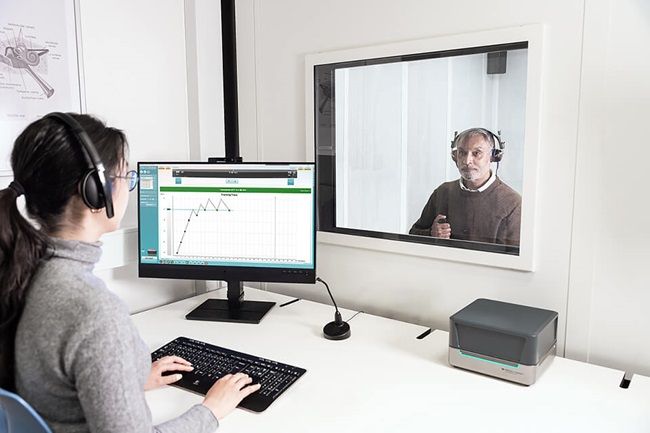QuickSIN vs. ACT: What’s the Difference?

This blog explains the differences between QuickSIN and the Interacoustics Audible Contrast Threshold (ACT) test.
What is the Quick Speech in Noise (QuickSIN) Test?
QuickSIN is a test that assesses an individual’s ability to understand speech in background noise. It consists of a series of sentences presented at different signal-to-noise ratios (SNRs), with the background noise level increasing gradually.
During this speech-in-noise (SIN) test, the test-taker must repeat five key words from each sentence. The number of correctly repeated key words is used to calculate the individual’s SNR loss.
A lower SNR score on the QuickSIN test indicates better speech understanding in noise, while a higher SNR score suggests greater difficulty with speech perception in noisy environments.
QuickSIN is valuable for identifying hearing difficulties related to speech perception in challenging listening situations and can aid in selecting appropriate hearing aid technology levels. QuickSIN scores can also be used to counsel patients and to monitor changes in hearing in noise ability over time.

QuickSIN test as seen on the Interacoustics AC40 audiometer
What is the Audible Contrast Threshold (ACTTM) Test?
The Audible Contrast Threshold (ACT) test by Interacoustics is a diagnostic tool that predicts aided speech in noise ability for individuals with hearing loss. Unlike traditional SIN tests, ACT is unique because it uses modulated noise signals instead of speech stimuli and shapes that stimuli according to the audiogram. This approach allows for precise assessment of a person’s aided hearing ability in noisy environments.
By using modulated noise signals, the ACT test is a language-independent evaluation, enabling accurate predictions of aided SIN performance regardless of the individual’s language background. This feature makes ACT a versatile tool for assessing a wide range of patients, including those who do not speak English.

Clinician performing the ACT test using the Interacoustics Affinity Compact
ACT offers a normalized Contrast Level (nCL) or ACT value, which accurately predicts how well a person will perform in noisy environments even while wearing hearing aids. The ACT value can be used to customize advanced features in hearing aids, leading to a more personalized and effective treatment approach.
QuickSIN vs. ACT Comparison

QuickSIN evaluates speech perception in background noise, specifically in English, providing an SNR score to represent the degree of difficulty. It serves as a counseling tool, aids in selecting hearing aid technology levels, and documents hearing in noise ability over time.
ACT utilizes modulated noise signals that are clearly heard by the patient, making it a language-independent test to predict aided speech-in-noise (SIN) performance. ACT serves as a counseling tool and aids in prescribing hearing aid technology levels and assistive listening devices (ALDs).
ACT offers a significant advantage over QuickSIN as it provides an accurate prediction of a patient’s real world aided speech in noise performance. It also supports hearing professionals in customizing advanced features in hearing aids based on the patient’s ACT value.
This capability enhances the level of personalized treatment provided. These adjustments can occur automatically based on the manufacturer’s software, or clinicians can manually adjust the hearing aid settings, depending on the software used. Also, since ACT is a non-linguistic test, it can assess patients who do not speak English.
QuickSIN Scoring versus the ACT Value
Scoring the QuickSIN test involves determining the SNR (in decibels) at which the patient can correctly repeat key words presented in six sentences. A lower SNR score indicates better speech understanding in noise. Higher SNR scores suggest greater difficulty with speech perception in noise.
QuickSIN Score Interpretation

ACT Value and Hearing Aid Fittings
The ACT value helps customize advanced features on hearing aids to make them work best for patients. It gives clear advice during the fitting process, which can improve how well the hearing aids work, especially in noisy places.
Furthermore, Oticon, Philips, Bernafon and Sonic hearing aids automatically take the ACT value into their fitting software to prescribe advanced fitting features. For other hearing aid brands, manual adjustments can be made during the fitting process using the ACT fitting advice.

Are you interested in learning more about ACT? Contact your local e3 Diagnostics sales representative today or visit our ACT page to submit a request.

Watch Now: ACTTM vs. QuickSIN with Dr. Ashley Hughes of Interacoustics
Other Good Reads: The Audible Contrast Test (ACT™) Quick Guide
